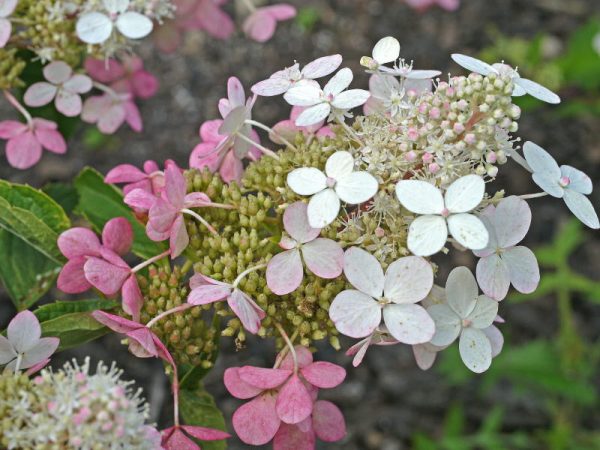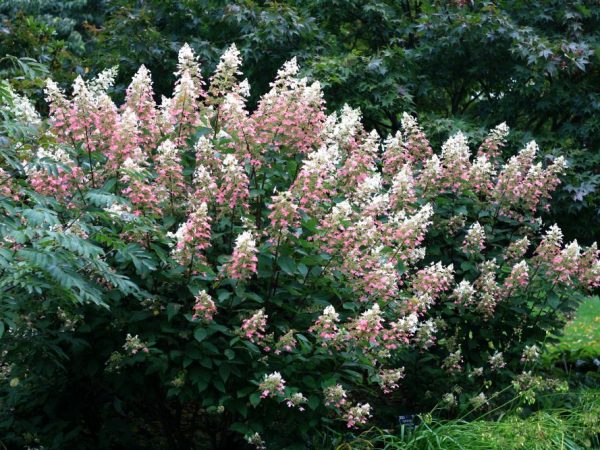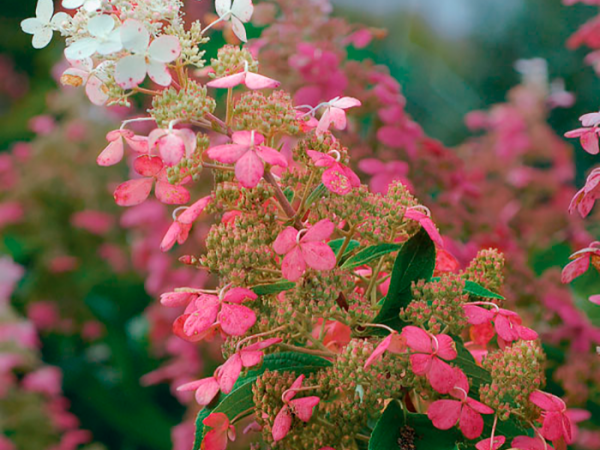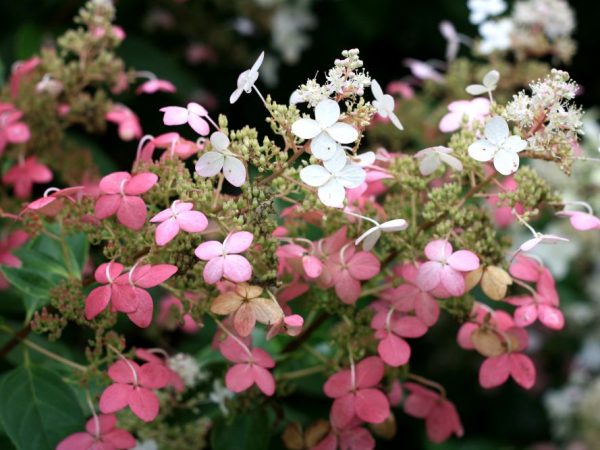Lacy Hydrangea Big Ben - the intricacies of growing and care
The Big Ben panicle hydrangea will be a real asset to any garden. Looks great both in a single version and in the company of other decorative crops. I fell in love with gardeners not so much due to unpretentious care and bright flowering, but also due to the ability to change the color of inflorescences throughout the season.

Hydrangea paniculata big ben
Description
Hydrangea paniculata Big Ben is represented by a perennial spreading bush of a symmetrical shape, it can reach a height of 2.5 m with a diameter of 1.8-2 m. Shoots are strong, red in color, covered with large ovoid leaves with jagged edges.
The flowering period is long - from June to September.
Inflorescences are formed conical up to 30 cm in length, visually resemble lace. At the initial stage of budding, the flowers are pale light green, which eventually gives way to white, then turns pink, and at the end of the season becomes deep pink.
Landing features
Term
In a cold climate, the procedure is carried out at the beginning of May after the end of night frosts, in the southern regions - at the end of September. When choosing a seedling with a closed root system, there are no time limits.
Seat selection
The plant is one of the thermophilic ones, so a well-lit area of the garden, protected from the effects of drafts, would be the best location option. It is also allowed to place a seedling in partial shade.
The soil should be fertile, with a high content of vermicompost and a neutral or slightly acidic environment with a maximum Ph value of 5.3-6.0 units. If necessary, to reduce the level of acidity, needles, peat or sawdust are added to the soil.
Seed preparation
When buying a seedling, there are some points to consider:
- Good survival rate is observed in specimens that have reached the age of 3-4 years.
- A young plant should have elastic shoots with rich green leafy plates and 4-5 growth buds. Average height - from 0.5 m.
- The optimal length of the root system (including closed) is about 30 cm.
Landing technology
The procedure is carried out according to the scheme:
- Dig a landing pit with dimensions of 0.6 * 0.6 * 0.6 m.In the case of a group landing, an interval of at least 2 m is maintained.
- The drainage layer is distributed from expanded clay, crushed brick, crushed stone.
- Part of the soil mixture is poured from garden soil, peat, vegetable humus and river sand. Additionally, a mineral complex fertilizer is added.
- A seedling is placed on top of the mound, the roots are carefully straightened.
- Fall asleep with the remaining substrate, tamp.
- Water abundantly. Mulch.
Care
Watering and feeding
The Big Ben panicle hydrangea loves moisture. With its deficiency, the plant stops in growth and development, the inflorescences become smaller and dull.

Hydrangea big ben photo
The frequency of watering directly depends on the weather conditions of the shrub growing area. In areas with a temperate climate, irrigation is carried out once every 7 days, in the southern regions - 2 times a week. Water is used settled warm at the rate of 3 buckets for each bush.
Provide long-term and abundant flowering of the culture through regular fertilizing, which is done repeatedly during the season.
Fertilization scheme:
- at the first stage of the growing season, they are fed with nitrogen preparations (including infusion of mullein, bird droppings);
- in the phase of inflorescence formation - phosphorus-potassium complexes;
- in the fall, at the end of the flowering period, with slurry.
Fertilize Big Ben once every 10 days, after spilling the soil with water in order to avoid getting burned by the root system.
Loosening and mulching
After watering, the moistened soil is gently loosened, being careful not to damage the roots of the Hydrangea. Additionally, the procedure allows you to get rid of weeds that provoke the spread of bacterial and viral diseases, as well as to normalize the degree of soil aeration.
Finally, the surface is mulched with a layer of sawdust or pine needles, which protects the underground part from freezing, overheating and rapid evaporation of moisture.
Pruning
Big Ben responds well to trimming. Make a haircut in the spring before the start of sap flow. In case of deviation from the terms and norms of the procedure, the risk of suspension of culture development and the absence of flowering increases.
During the process, a number of rules are required to be observed:
- dried branches that have not survived the winter are cut off under the base;
- shorten last year's shoots by ⅓ of the entire length;
- bushes from the age of 5 years are completely cut off, leaving shoots with a height of 7-8 cm;
- keep faded inflorescences intact, because they prevent the freezing of flower buds.
Preparing for winter
This variety of Hortense does not need shelter for the winter. The exception is those specimens that have not reached 2 years of age or are cultivated in areas with severe weather conditions.

Hydrangea paniculata big ben
In this case, the branches of the plant are tied with twine, laid on the ground and covered with straw or deciduous litter. Either spruce branches or non-woven agrotextiles are distributed on top. They remove the cover in spring, when the threat of frost is guaranteed to pass.
Reproduction
Hydrangea can be propagated in several ways - seed and vegetative. In amateur gardening, seed propagation is rarely practiced due to the laboriousness and duration of the process.
Cuttings
In this case, the apical part of a healthy shoot 10-15 cm long is cut off from the plant and placed at an angle of 45 degrees into a moist substrate. To create a greenhouse effect and accelerate rooting, a glass jar is placed on top or a film is stretched.
When the cuttings get stronger, the shelter is removed, and the container is transferred to a warm, well-lit place. After 3 years, young shrubs are transplanted into open ground.
Layers
To obtain layering in the middle of summer, the side branches are bent to the ground, having previously dug a hole 10 cm deep, and sprinkled with soil. To stimulate root formation, the shoots are slightly incised where they are supposed to be immersed in the substrate. Subsequently, the seedlings are given standard care and are separated from the mother plant in the spring of the following season.
Rhizome division
This method is applicable only if Hortensia reaches 5 years of age and needs to be transported to another place. During the event, they dig in the bush with a shovel, cut off part of the root system and move the plot to the prepared hole.

Hydrangea paniculata big ben description
Diseases and pests
| Name | Signs | Prophylaxis | Treatment |
| Powdery mildew | A gray dust-like bloom on the outside of the leaf, then spreads over the entire surface, affecting the shoots, eventually acquires a dense structure and a brown tint. | The recommended feeding rates are observed (the ailment often occurs with an excess of nitrogen and a lack of calcium) and the watering regime. Sprayed with sulfur, a weak solution of potassium permanganate. | Remove the affected areas, additionally remove the top layer of the substrate and change it to a new one. Folk remedies: ash-soap, mustard, milk solution. |
| Chlorosis | The leaves turn yellow, while maintaining the natural color of the veins, become smaller, curl around the edges. The inflorescences fly around, deform, the tops of the shoots dry out. | They use only disinfected garden tools, timely fight against pests, fertilize. | Normalize the content of trace elements in the soil: with a lack of iron, use Ferrovit, Ferrilene, Iron Chelate; in case of magnesium deficiency, add Mag-Bor, dolomite flour, magnesium sulfate. If there is not enough sulfur, Kalimagnesia, Azofoska, Diammofoska are used, if zinc is zinc oxide, zinc sulfate. Calcium is replenished with wood ash, eggshells, slaked lime. In case of infection with infectious chlorosis, the bush does not respond to treatment (it is dug up and burned). |
| Ring spot | Light areas on the surface of the laminae reticulate or annular / necrotic dark spots. Suspension in the growth of the entire plant or an individual segment. | Marigolds, chrysanthemums, pyrethrum, castor oil plant are planted nearby (they are enemies of nematodes, which are considered one of the causes of the disease). They do sanitary haircut, weeding, pest control in a timely manner. | There are no means to fight. The affected culture is uprooted and disposed of. |
| Gray rot | In the initial stage, the lower leaves are covered with light brown spots of irregular shape, which, as they progress, spread throughout the shrub and acquire the texture of a fluffy mycelium bloom. | Avoid thickening and crowding of plantings, periodically thin out the crown, keep the site clean, in a cloudy summer, nitrogen-containing fertilizers are excluded from fertilizers. | Purchased drugs: Euparen Multi SP, Rovral SP, Topsin M, Maxim, Trichophyte, Apirin B. Traditional methods: spray with a solution of potassium permanganate (4 g per 1 liter of water) twice a day for a week. |
| Spider mite | Thin, almost transparent cobweb, white blotches on the surface of the leaves. | The beds are regularly weeded, they do not allow the substrate to dry out, they are treated with an infusion of garlic, and formulations with high levels of phosphorus and potassium are used as fertilizers. | Folk remedies: medical alcohol, a decoction of cyclamen tubers, tincture on onion peels. Systemic drugs: Fitoverm, Aktofit, Vermitek, Apollo, Iskra-Bio, Bitoxibacillin, Tiovit-Jet, Fufanon-Nova. |
| Aphid | Deformed tops of branches, twisted leaves, sticky bloom. Nodules are formed, buds do not develop, inflorescences acquire ugly shapes. | Weeds and plant residues are disposed of in a timely manner, they fight ants, attract birds to the territory, and are treated with a special composition every month. | The pest is mechanically removed, the shoots are thoroughly washed with water with the addition of laundry soap. Folk remedies: ash-soap solution, chamomile, garlic, marigold, pepper, tobacco infusion. Purchased preparations: Confidor, Iskra-Bao, Decios, Calypso Spray, Tanrek, Floristin, Tsvetolux. |
Testimonials
Based on the opinion of experienced gardeners, we can conclude that Big Ben hydrangea is an unpretentious shrub with high frost resistance, capable of pleasing abundant flowering for a long time.

